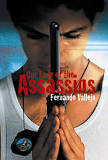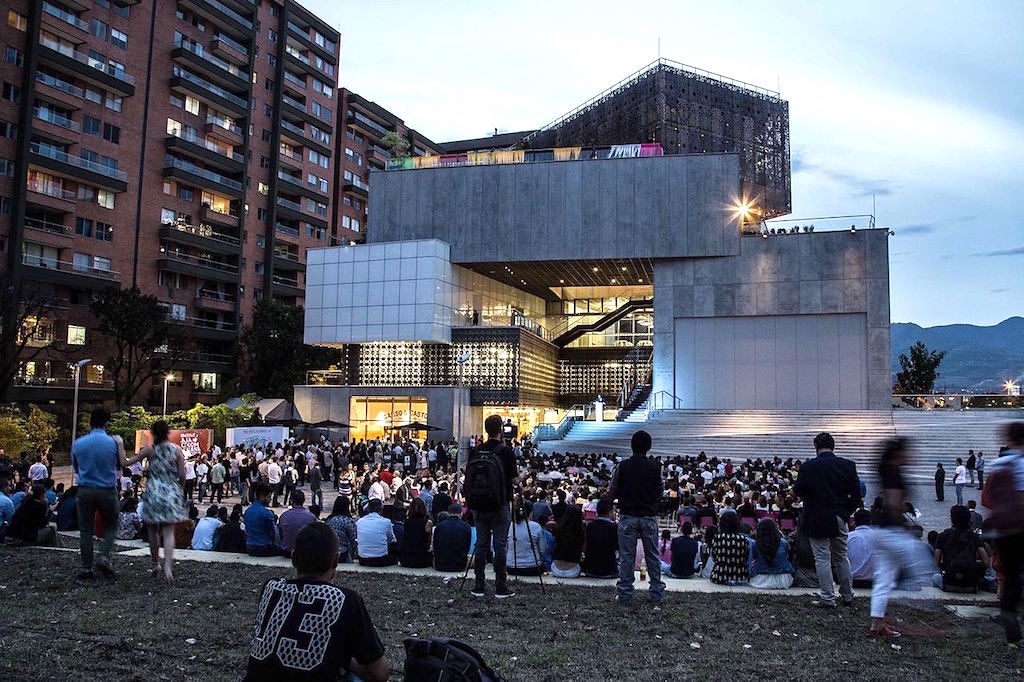During my Easter visit to Sabaneta, Viviana had mentioned La Iglesia de Santa Ana was known as the church where sicarios (assassins) go to pray.
When I laughed at the ridiculousness of murderers asking for protection, forgiveness, or whatever else from God, she referred me to La Virgen de los Sicarios (Our Lady of the Assassins), a movie based on the autobiography of Colombian writer Fernando Vallejo.
Within the first five minutes, we’re introduced to the protagonist, Fernando, who has returned to his hometown of Medellin after 30 years of travel abroad.
Fernando is a writer who enjoys questioning everything in life as though he were a philosopher too.
He visits a gay brothel run by an old friend, and it is there that he’s introduced to Alexis, a teenage prostitute, and sicario, whose former gang was killed off.
Fernando isn’t shy about stating he’s slept with 1,000 boys, nor that his reason for returning to Medellin is “to die.” Why, we’re never told, though by the end of the movie, ironically, he seems to be the only one left alive.
In the brothel, as Alexis begins to undress, he drops a handgun on the floor, at which point he confesses that it’s for protection, as there are others who want to kill him.
Can a man of 60 have a romantic relationship with a boy of 16? In a sane world, no. They would drive each other crazy. In a world where both expect to die in the immediate future, where plans are meaningless, where poverty of body and soul has left them starving in different ways, there is something to be said for sex, wine, music, and killing time in safety. — Rogerebert.com
A few things strike me from these first five minutes of the film. Medellin has a reputation for beautiful women, yet the whole movie revolves around gay men.
Fernando appears to be in his late 40’s or 50’s, with a world of experience under his belt (literally).
He could easily be Alexis’ father, and at times their relationship seems more like father/son than that of lovers. As likable as he is, I can’t help but see Fernando as a child predator.
If offending the audience is art, then this is art. To use the gay sex culture as a paradigm for exploring the culture of the teenage assassins is, well, brilliant. Their fleeting lives have about as much value as the binary combatants in a video game or a film fantasy such as The 10th Victim… yet a peculiar feminine dignity becomes them when they seek love…. — Culturecourt.com
Fernando takes an immediate liking to Alexis, and asks him what he’s doing the next day. Alexis responds that he goes on a pilgrimage to church in Sabaneta every Tuesday, and invites Fernando along.
On the taxi ride to Sabaneta, Fernando asks the driver to turn down the vallenato music, but he ignores him, and then kicks them out of the cab, calling them “faggots” as he speeds off.
Alexis responds that the driver got off lucky, because it’s a holy day, otherwise he would’ve killed him.
Later, we learn he was serious when he casually kills Fernando’s noisy neighbor in the street, and a different taxi driver who refuses to lower the radio volume (and to be fair, also physically threatens Fernando with a makeshift machete).
Upon leaving the church, Fernando witnesses his first drive-by shooting, which occurs on the steps of the church itself. This becomes a pattern in the movie, of first visiting church, and then witnessing murders.
Alexis attributes the violence to warring gangs from Santo Domingo, the calmer neighborhood today, which hosts the metrocable to Parque Arvi.
Soon after, Fernando witnesses an attempted carjacking on a walk to the pharmacy, that left the car’s owner, who resisted, dead at his feet. Fernando states he’s against violence, yet because he plans to die soon himself, seems increasingly numb to the carnage.
One of my favorite scenes is at 28:50 when they’re in a park, buying empanadas, and Fernando comments on how stingy the vendors are by slicing up napkins.
“A fly couldn’t blow its nose in it” he says.
And I couldn’t agree more! I can’t stand small napkins, especially at sit-down restaurants. Not that this is specific to Colombia, as you’ll encounter it throughout developing world.
Small bits of humor aside, La Virgen de los Sicarios (Our Lady of the Assassins) is a sad reflection of the continued challenges Medellin and its citizens have had to face in the years since Pablo Escobar was killed.
Locations Featured in the Movie
9:25 – Sabaneta
17:00 – Which mall is this?
21:29 – What’s the name of the white church?
23:28 – Versalles Restaurant (Centro) – “Carrera Junin. Best empanadas argentinas y chilenas in Town! Ask for Don Leo.” Tweet by @npmedellin
26:50 – What’s the name of the white church. Is it the same one as earlier?
29:12 – Plazuela y Iglesia de San Ignacio (Centro)
35:50 – What’s the name of this park with the Simon Bolivar statue? And the nearby cathedral?
48:15 – Which park and church is this?
52:45 – Patio del Tango (Barrio Antioquia) – Argentine parilla featuring live tango music and dancing.
1:17:18 – Iglesia de San Antonio
1:21:23 – Grosty Cafeteria
1:27:52 – What’s the name of the white church. Is it the same one as earlier?
1:31:40 – What’s the name of this motel?
Can you recognize any of the parks or churches above?
Please share the name along with the time (hour:minutes:seconds), and we can build a running list.












